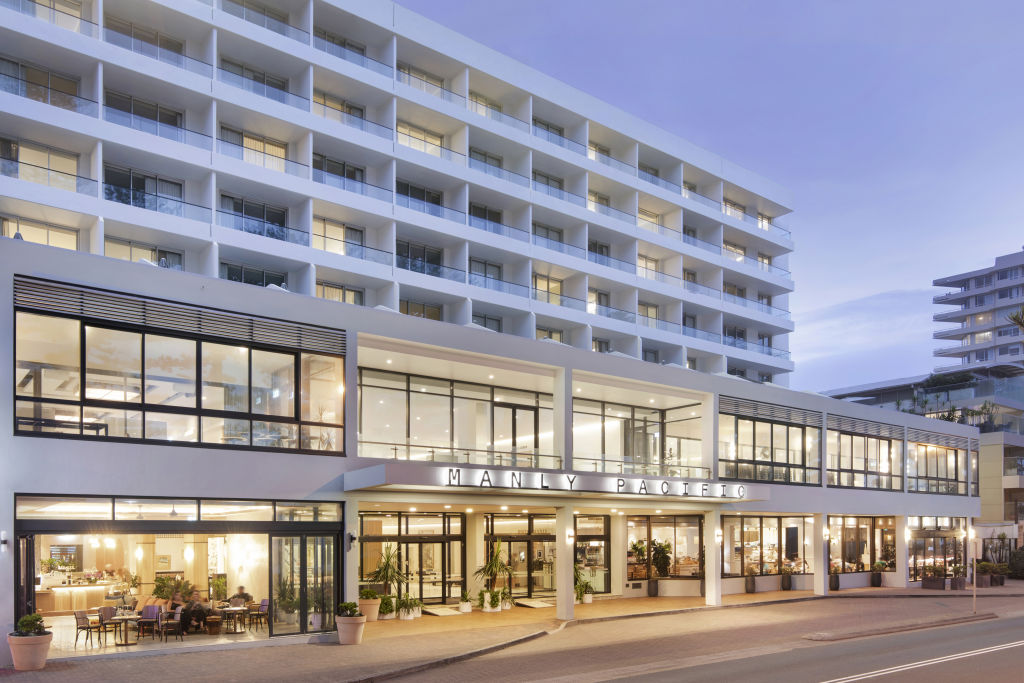At a time when no one knew if the pandemic-plagued world would ever return to normal, the old hotel on the beachfront at Sydney’s Manly was undergoing a light touch-up.
But when the COVID lockdown forced it to close, the owners took an extreme leap of faith in the Australian hotel industry – and turned that three-month “refreshment” into a two-year $30 million total refurbishment.
And so far, so good.
“I think everyone realised that we needed to change because of the pandemic,” said Dylan Cole, general manager of the Manly Pacific. “We were unsure how much we could do, but then we went from the rooms and corridors into the lobby and bar and rooftop and pool and amenities.
“In the end, it became a complete repositioning in the market from a mid-scale, low-rate-high-volume hotel into a luxury hotel, which is all about the experience you can have there. It was a risk but it’s been really welcomed by both our guests and the locals, who see us as having returned an iconic hotel back to Manly.”
Just like many other commercial real estate owners who took the enforced break from business as the chance to completely overhaul their properties, the Manly Pacific’s managers and owners have seen return business buoyant.
As the luxury Sofitel Noosa Pacific Resort is also in the owners’ portfolio, they were keen to push their Sydney northern beaches’ hotel to reach a similar standard.
The 40-year-old hotel, most recently operating as a three-star Novotel, was looking tired and a little shabby around the edges. Now, as the five-star Manly Pacific – MGallery, one of the collection’s 111 boutique hotels around the world, its facade has been redone and its 213 rooms redesigned to include a new 177-square-metre one-bedroom suite, The Infinity Residence, with a 100-square-metre terrace, and nine ocean-facing coastal suites.
In addition, it has the rooftop pool and bar, a sundeck, a new lobby bar and the refurbished conference and events floor. The average room price is now $350-$400 a night, compared to $250 beforehand.
“It’s one thing to commit to the investment, but it’s another to see how it’s greeted by the guests,” said Cole. “But we’re really proud of our guest sentiment scores; we’ve had an incredible reaction since our reopening.”
A lot of that has to do with the redesign team, too, from Coco Republic. Senior interior designer Georgina Holmes of the global interior design team, says the concept for the hotel and palette had already been worked out for the initial refresh with new paint, carpets and furnishings, but it was simply extended for the major refurbishment as bathrooms were pulled out and changes were magnified.
“It was looking tired and pretty dire and had dark walnut joinery, everything was very beige and mushroom, and there were plastic shower curtains in the bathrooms,” Holmes said. “You really don’t expect that of an ocean-facing hotel.
“We wanted it instead to be an aesthetic we call ‘coastal luxury’ or ‘homely elegance’ where it’s beautiful but guests feel relaxed enough to put their feet on the coffee table. We used a much warmer palette with travertine throughout the hotel to replicate the colour of the sand and soft eucalyptus greens from the colour of the pine trees. We also have no art, just mirrors, as the view is the art.”
Among the admirers of the new hotel has been the original architect of the building, Soo-Tee Cheong, who visited with his family to inspect its revival. He said he was delighted with the “most remarkable” refurbishing.
“I was truly delighted to hear the reason for introducing the travertine into the rooms to reflect the beauty of the golden beach sand,” he said. “It is a profound understanding of my vision of connecting the building to the beach. A very ingenious way of evoking the sense of presence on the beach, the connection and harmonious relationship between the beach/ocean and the building is cleverly maintained through the subtle interpretation of my original intention.”
